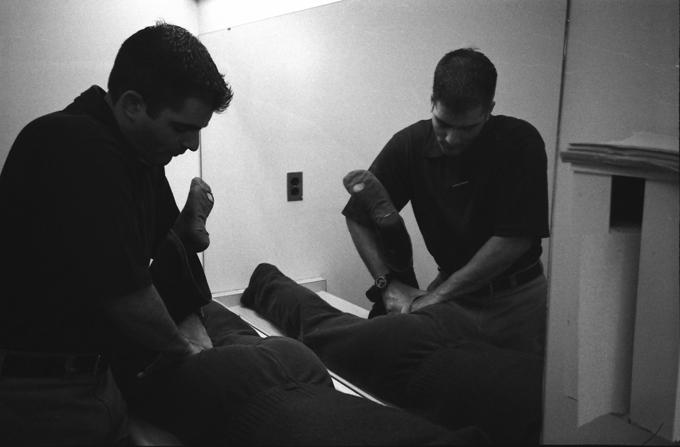By Sean Fitz-Gerald
Most guys would leap at the chance to get out of taping, stretching and massaging hairy, sweaty guys to work with dancers.
But Lenny Ferraro, a 25-year-old athletic therapy student from Sheridan College, just looks at the change as an opportunity to learn more about his chosen career.
Ferraro is the main athletic therapists for the Ryerson men’s basketball team. Last week, however, he found himself in the basement of North Kerr Hall taping and stretching dancers during their opening performance of Choreographic Workshop ’99.
“One of our main objectives is to expose ourselves to as many different areas of the file, and I’ve never worked with dancers before,” Ferraro said.
“People don’t come in here and say, ‘I just got hit by another dancer,’” Ferraro said.
He was the first athletic therapist ever to work with the dance program during a performance. The dancers have never had support staff for previous events.
Usually, dance students would have to schedule an appointment in Ryerson’s athletic therapy clinic and get taped during the day. The problem was that athletic tape has a tendency to loosen in 15 to 20 minutes — making it useless for a performance hours later.
Third-year dance student Kara Purdy got fed up with the lack of attention dancers were being paid. One day in the clinic, she asked Ferraro why there wasn’t anybody to help dancers with injuries during performances, while sports teams have trainers. Ferraro went to his professors and got permission to work backstage with Ryerson’s dancers.
“We got [to the clinic] just hoping they can fit us into their schedule, but they can’t always do that,” she said.
Purdy was happy to have Ferraro cover the recital.
“You have a sense of security knowing that someone is here,” she said. “If you hurt yourself, there is someone here to ask questions.”
Ferraro converted a changeroom behind the theatre into a makeshift training room. When dancers needed help stretching, they had to lie on a counter.
Second-year dance student Olympia Farmakidis had her feet dangling into the sink as her legs were being stretched.
“I think it’s important for us to have [support] because we work our bodies very hard and we get injured often,” she said.
Dancers’ injuries may not always be a gruesome as, say, those of football or basketball players, but they are painful. Split toes, twisted ankles, tendinitis and muscle spasms are common.
“They don’t treat us like athletes, but we are athletes,” said Farmakidis. “It really feels good to have someone help us.”
Ferraro is more than happy to help. “It’s different from basketball — the dancers don’t smell as bad,” he said.











Leave a Reply